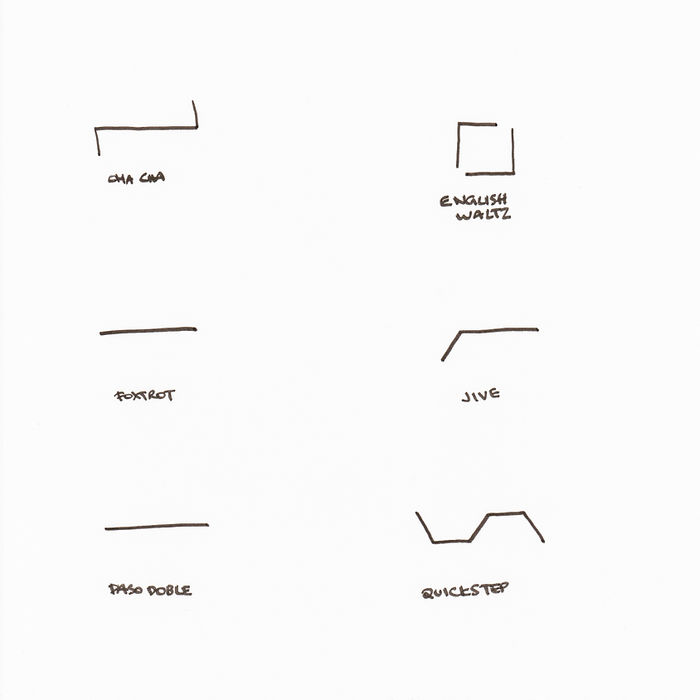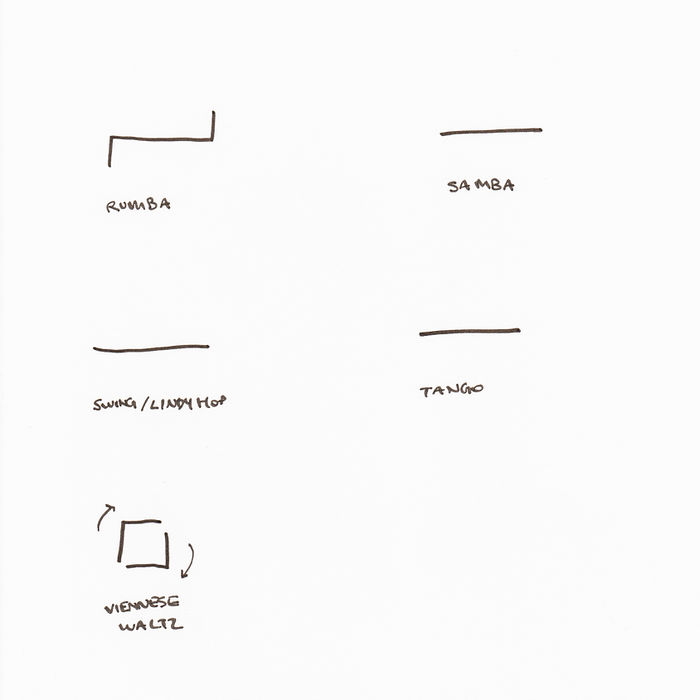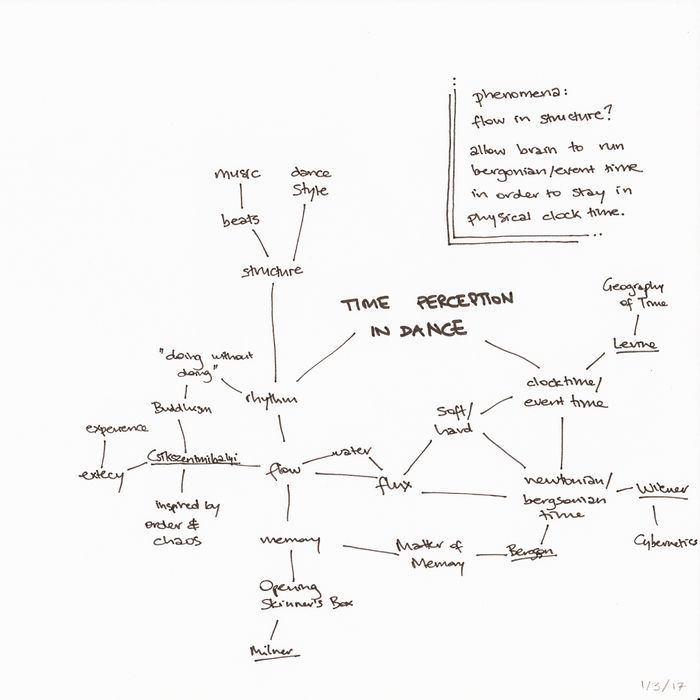Karina/special issue 02 individual research
13 MARCH
new changes
- no screen - find new way to view queued instructions and choreology
- no direct usb connection to use keyboard. need dongle
10 MARCH
What still needs to be done
Doable steps:
- List all moves from a dance (in official terminology) and give them a correlating number.
- Create code that interprets numbers into terminology
- Create terminology / instructions as markup text
- Convert markup text into audio
Further steps:
Commands will be said only every 8 beats in the song.
- Is there a way to queue commands / terminology?
- How to have the spoken instructions told through the speakers at the right moment?
Music will take up too much space on the floppy, so that might need to be external.
- How to sync the speed of the song to the spoken instructions intervals? BPM calculator (different songs = different BPM)
- How to communicate BPM to queue tempo?
- Can the Pi read any language?
- Does it have an operating system (which one), or is it just a shell?
- Are there any limitations to any language I could be using?
- Is making a web interface using Java Script and then connecting the Pi to a screen possible?
printing the choreology?
Music alternatives
Swing / Jive midi
https://www.youtube.com/watch?v=v0ZOo2DMack
https://www.youtube.com/watch?v=E6XACt1s-z0
Other dances
Foxtrot https://www.youtube.com/watch?v=vW3w8kV-Xmo
Quickstep https://www.youtube.com/watch?v=stsBqdo9Svc
Samba https://www.youtube.com/watch?v=sY20ixaf2PM
Waltz https://www.youtube.com/watch?v=vCKU5gwXQRo
7 MARCH
Time Perception in Dance - essay for Methods
https://pzwiki.wdka.nl/mediadesign/Karina/time_perception_in_dance
2 MARCH
Experiment
- List all dance styles
- Illustrate movement using choreology
- Explain rhythm in words
- Illustrate rhythm using choreology
- Analyse differences between dances
1 MARCH
22 FEBRUARY
https://pzwiki.wdka.nl/mediadesign/Joana%27s_Thesis_Outline
21 FEBRUARY
Choreomusicology (list of artists that create choreologies)
https://en.wikipedia.org/wiki/Choreomusicology
Merce Cunningham - created choreology (worked with Cage and Tudor)
https://en.wikipedia.org/wiki/Merce_Cunningham
Feuillet notations
https://en.wikipedia.org/wiki/Beauchamp-Feuillet_notation (17-18th century)
http://www.baroquedance.com/research/dancenotation.htm
http://www.contemporary-dance.org/how-to-write-feuillet-notation.html
George Balanchine (ballet choreographer)
https://en.wikipedia.org/wiki/George_Balanchine
Rudolf Benesh - mathematician created movement notation
https://en.wikipedia.org/wiki/Rudolf_Benesh
https://en.wikipedia.org/wiki/Benesh_Movement_Notation
Igor Stravinsky notation
https://en.wikipedia.org/wiki/Igor_Stravinsky
Lebanotation 1920s, still used today
https://en.wikipedia.org/wiki/Labanotation
Still used today because it takes many factors into consideration
- Direction and level of the movement
- Part of the body doing the movement
- Duration of the movement
- Dynamic quality of the movement
Anne Teresa de Keersmaeker - dancer that draws dance with footprints
https://www.moma.org/calendar/performance/1580
https://www.youtube.com/watch?v=E1OHl8_MPEg (Performance 13)
20 FEBRUARY
Experiment: Learning Swing Basics
How similar is it to what I already know from ballroom?
How similar is it to a Jive?
How long will I need to learn the first level?
Will I manage to remember the terminology?
Will I remember the dance once I get home?
Will I be able to fall into a flow? How long will it take?
What will be the experience / connection with a new dance parter?
Is Swing just as addictive as they say?
Task:
- Find new dance style to try
- Organise private classes with an instructor
- Note down questions that arose before the class
- Go to dance classes unprepared (didn’t look up steps, rhythm or what to wear)
- Note down experience once the class is done
13 FEBRUARY
http://www.luckytv.nl/gaga-dazzles/
1 FEBRUARY
Experiment
What would happen if we broke down the structure / order of the dance?
How will that effect the flow?
How will our memory work?
Will we be more conscious of what we are doing?
Will I need to let my parter lead me more? More trust if less anticipation?
Task:
- Select 6 steps from a Jive
- List them in order using names / terminology and number them 1-6
- Roll a die and note down the outcome
- Repeat step 3 a couple of times
- Rewrite steps in new order using step names / terminology
- Dance the re-constructed Jive
- Describe experience (use questions from above)
Jive first 6 steps
- Basic Turn
- Follow the Leader
- American Swing
- Bump
- The ‘1-2’
- Windmill + Spanish Arms
New order
3 - 1 - 6 - 2 - 4 - 2
American Swing
Basic Turn
Windmill + Spanish Arms
Follow the Leader
Bump
Follow the Leader
28 JANUARY
Some screenshots of my 'sketchbook'
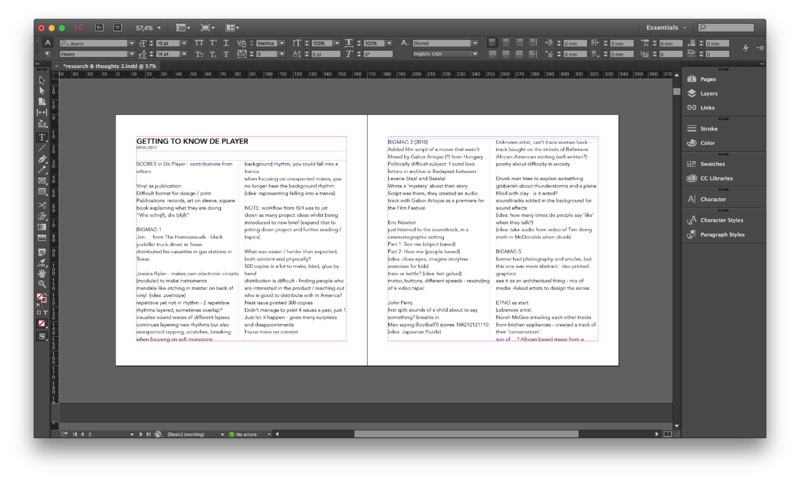
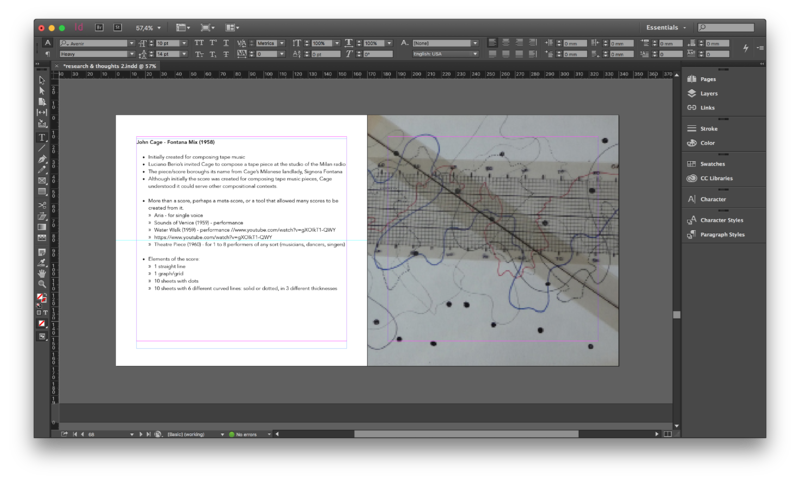
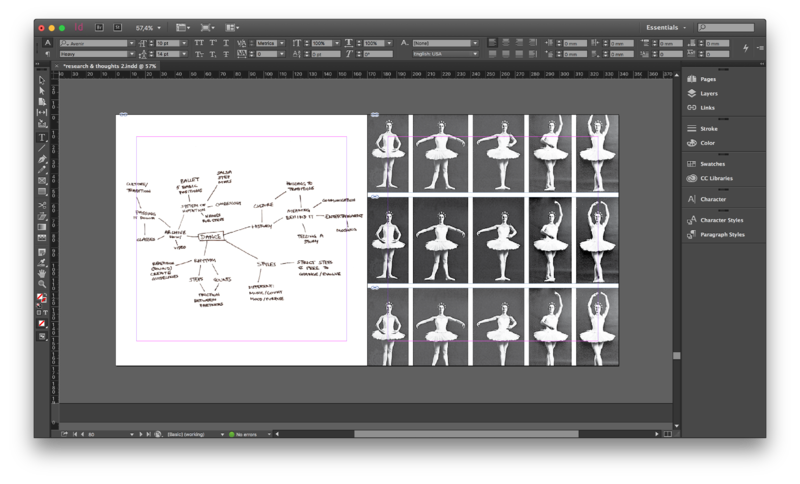
23 JANUARY
In my previous years I created nicely printed and bound 'sketchbooks' during any project. Any research would get printed, stored in a chronological order in a folder, and by the end of the project get bound into a book. I'd like to show the process of the score project this way too. The content would be:
- meeting notes
- pushing the score sessions
- experiments
- own thoughts / analysis
- own research and visuals
MID JANUARY?
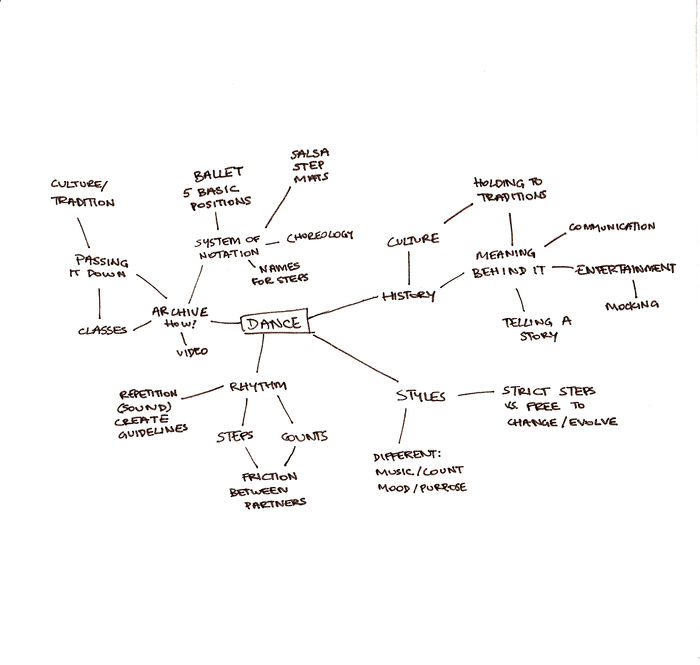
https://www.ted.com/talks/camille_a_brown_a_visual_history_of_social_dance_in_25_moves#t-264680
{{#ev:youtube | https://www.youtube.com/watch?v=OO6oPDwDzQs}}
Marian Wieczysty - Tańczyć może każdy (1986)
Slawomir Mrozek - Tango (1986)
http://www.e-teatr.pl/pl/programy/2013_12/56364/tango_teatr_mickiewicza_czestochowa_1986.pdf
CYMATICS: Science Vs. Music - Nigel Stanford
https://www.youtube.com/watch?v=Q3oItpVa9fs
10 JANUARY
Dance
- (idea: an occasion to nally lm all dance routines with Sean)
- Can we dance certain routines to different music styles / counts? Waltz at a 4 (not 3) count. Join Swing Basics / Charleston Green classes
- Read into notation systems for choreographers - what are they? will they be easy for me? can I read them without instructions?
- (idea: note down dance instructions. differentiate right / left foot by colour - right=blue, left=red)
- (idea: make rules to interpret score as a dance/choreography)
- (idea: let dice decide next move in jive. American Spin=2, Spanish Arms=3, Windmill=4)
- viewer could get involved by throwing dice, but performance cannot be archived / recreated
- (idea: how could it be connected to twister? - chance dedicates colour / movement)
- Some artist bought too many samples for the company to handle. This raises the question of whether the system needs upgrading. What questions does dance raise? Tango has storyline, Jive has African slave history (look into dance video)
- Look into history of different dances
- “The best way to predict the future is to invent it” - Alan Kay (1971)
- How could we predict the future using dance?
- Take possible news and correlate them to dice (chance) which is correlated to dance moves Take dance moves that are correlated to dice (chance) and correlate them with possible news
- Michiel Schuurman - new form of harmony using glitch
- Translating one type of content to another (python!) analog to digital
- Look into Alan Kay
Language
- Ask about artist (white record sleeve with black scattered letters on the wall) Find Letter from Santa
- Play around with Google Translate and speaking in different languages
- look into old project ideas: false auto correct in different languages?
9 JANUARY
Jessica Rylan
makes own electronic circuits (modular) to make instruments
mandala-like etching in master on back of vinyl (idea: zoetrope)
when focusing on unexpected noises, you no longer hear the background rhythm (idea: representing falling into a trance)
Eric Newton
(idea: close eyes, imagine storyline - exercises for kids)
train or kettle? (idea: het geluid)
John Perry
Man saying (football?) scores 104212121110 (idea: Japaanse Puzzle)
Unknown artist, can’t trace woman back
Drunk man tries to explain something gibberish about thunderstorms and a plane lled with clay - is it acted? soundtracks added in the background for sound effects
(idea: how many times do people say ‘like’ when they talk?)
(idea: take audio from video of Tim doing math in McDonalds when drunk)
Michael ...
recordings of Biranja language of Indian’s that travelled to Suriname to work (1988)
songs told stories of homeland but also about moral issues / life
Songs were later translated (text). This language was chosen because it is dying, due to migration / fusion with Surinamese (idea: how can language shape culture?) (idea: force google translate speak text from one language written phonetically in another - Message from Santa)
(idea: look into Polish language surviving thanks to sung / spoken prose / poetry - check artists that parents listened to) (idea: why / how does rhythm force us
to move? Gaudi’s work forced people to interact with it - staircase)
(idea: look into experience of Sri Lankan youth playing drums and singing in
train from Ella to Kandy. First traditional, later interacted with tourists and played commonly known melodies - Justin Bieber)
Records came in different sizes
3” records used for Spreekpoppen (speaking dolls from East Germany)
They could say ‘hello’ (idea: or they could sound demonic)
8” Transparent square record in perspex demonic sounds layered on drum rhythms and random sounds (Michael joked about Shazaming it)
(idea: everything is a remix. what if you shazam songs that play only music, without the lyrics that make it clear it’s a remix. How many versions can it nd? example of dad learning to use shazam)
Leif Lewin
sound reproduction
2 moulds and poured in liquid to create record
Image / etching of Jesus face is still carved in a spiral
Original Jesus face was carved in 1649 Track is the recording of touching the copper plate of the face
(idea: look into photo of female body covered with Brail)
Language and sounds William Burroughs look into DADA sound
look into white cover with scattered letters (on the wall)
(idea: Tim trying to speak Polish by glueing continents / sounds together

